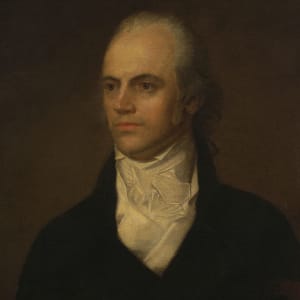The Life of Aaron Burr; The Man Who Killed Hamilton

Image via Biography
February 1, 2022
Aaron Burr was born on February 6, 1756, in Newark, New Jersey. His father, Aaron Burr Senior, was the president of the College of New Jersey and was a Presbyterian minister. His mother, Esther Edwards Burr, is said to have been more forceful and knowledgeable in her religion than Aaron Burr Senior. Aaron Burr had one older sister, named Sarah, who joined him in experiencing a childhood led by politics and religion. In the years 1757 and 1758, Burr’s parents died, leading him and his sister to move in with their grandparents. Their grandparents soon died of yellow fever the same year they came to live with them, and they moved again to live with their wealthy maternal uncle.
Aaron Burr studied and went to the College of New Jersey (now known as Princeton) at the age of thirteen, and graduated at the age of sixteen. He also attended a religion and law school named Litchfield Law School, before his studies were put on hold when he voluntarily enlisted in the Continental Army around 1775. He began his service under Benedict Arnold in the “March of Quebec,” and is said to have tried to evacuate the body of General Richard Montgomery after he was killed during the invasion.
In early 1776, Burr achieved the rank of major and was appointed to serve under George Washington in New York. Burr did not get along well with Washington and soon left his service after only a few weeks. He became an aide-de-camp for General Israel Putnam and saw action in the Battle of Long Island. He did an array of posts for General Putnam until he eventually retired from his commission in 1779.
In 1780, Burr returned to studying law. During the year 1782, he became a licensed attorney and was admitted to the bar. Burr then moved to New York and began a successful private practice in Albany. He would spend the next six years practicing law in a shared practice with Hamilton, and would eventually be appointed attorney general of New York in 1789.
Just after passing his bar exam, Burr married a widow of a British officer named Theodosia Prevost in 1782. They had first met in 1778 on a five-day sail to New York and visited each other many times. In 1783, Theodosia gave birth to Theodosia Burr Alston, who grew up with the best possible education and was regarded for her intelligence and sophistication.
In 1791, Burr beat Hamilton’s father-in-law, General Philip Schuyler, for a seat in the U.S. Senate. The battle for the seat in the Senate led to the onset of the ongoing rivalry between Aaron Burr and Alexander Hamilton. After six years in the seat in the Senate, Burr lost re-election to Schuyler. Burr blamed Hamilton for his loss and believed that Hamilton had ruined his reputation and turned voters against him.
Even though Burr faced hard times in his position in the Senate, he and elder Theodosia would remain happily married until she died in 1794. Theodosia died of stomach cancer, which has been said to have caused her to suffer side effects long before her death. Burr tried to get her the best care available at the time, but it was not able to help the ill Theodosia. After her death, Burr was devastated, and focused all of his love on young Theodosia and devoted himself completely to his work.
In 1800, Burr ran for the U.S. presidency against Thomas Jefferson. Each of them received the same amount of electoral votes, so the House of Representatives had to determine the winner. When the House met to discuss the decision, Hamilton spoke of his dislike of Burr and placed his vote with Thomas Jefferson. The House voted Thomas Jefferson as president and Burr as vice president. Burr was livid, believing that Hamilton had manipulated the vote against him.
In 1804, Burr ran for Governor of New York and lost by a landslide. Once again, Burr believed his loss was caused by Hamilton’s political involvement. For Burr, this was the final stroke Hamilton would place against him. He declared a duel with Hamilton, and they faced off at Weehawken. The duel took place on the morning of July 11, 1804, and ended when Burr shot Hamilton above the right hip. It was a shot that fractured one of Hamilton’s ribs, tore through his diaphragm and liver, and then lodged itself into his spine. It has been recorded that Burr wore a look of regret and tried to walk towards Hamilton before he fled from the scene.
Burr fled to New York and New Jersey, and eventually returned to Washington D.C. when his warrant had expired. He would never be able to be prosecuted for the duel, and his case will never reach trial.
Later on, in 1807, Burr was brought to trial on charges of conspiracy and high misdemeanor because of his involvement with the possible capitalization of a war with Spain. With Burr’s political career in ruins, he was acquitted in the trial and soon sailed to England in 1808 to gain support for a revolution in Mexico. He began to travel to Sweden, Denmark, Germany, and Paris, but was unable to get support for a revolution.
Burr admitted defeat, but was so penniless that he could not even travel home to New York. He was eventually able to travel by a French ship in 1811, but it was captured by the British. He was detained in England until 1812 before he was finally able to return to New York in the United States to pursue his law firm once again.
In 1813, Theodosia Burr died in a shipwreck that occurred in a fierce storm. It is also believed by some historians that she died in an attempted pirate robbery, but will never be known for sure due to no evidence of the people and the crew on the ship. Burr was extremely worried when he didn’t hear from Theodosia after weeks passed without a letter from her, and the news of her death led to the complete destruction of Burr’s life.
By 1830, Burr had become completely dependent on his friends’ financial support and relied on them for a place to live. His law firm had a medium amount of success, but not enough for Burr to make a living wage from. In a chance of luck, in 1833, Burr married a wealthy widow that solved his money problems for a short time. He married Eliza Jumel, but they quickly divorced after only four months due to her money dwindling.
Following their divorce, Burr had multiple strokes that led to him becoming partially paralyzed. He died under the care of his cousin on September 14, 1836, on Staten Island, New York. On the day of his death, the divorce was finally granted to Eliza Jumel, which she had been trying to get passed since month one in their marriage.
Following Burr’s death, historians have also discovered that Burr had two other children along with Theodosia. Aaron Columbus Burr and John Pierre Burr were both said to be born from slave mothers and were kept separate from Burr’s affairs in society.









































































































































